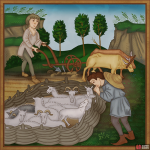Text
In the Middle Ages, a significant portion of people’s wealth consisted of livestock: horses, goats, cattle, and poultry.
The horse was highly valued and, until the 12th century, was kept only for the nobility, for military purposes, and light draught work. This changed during the 12th and 13th centuries, when horses came to be used for transportation and ploughing.
In Bohemia, horses were shod with horseshoes from the 11th and 12th centuries. Until the 13th century, horseshoes were mostly applied only to the front hooves, but later, as horses began to be used for heavy work, all hooves were shod.
Almost every serf in the Middle Ages preferred to own a cow rather than a piece of arable land, so even landless peasants had access to food in the form of milk. Interestingly, milk and dairy products were not in high demand during the Middle Ages. This was partly because almost everyone kept a milking cow, but also because reliable methods of preservation were not yet known.
Both serfs and the nobility kept sheep, primarily for their wool. The poorest people kept goats for milk and cheese.
Pigs grazed in the forests all year round, feeding mainly on beechnuts and acorns. Medieval pigs resembled wild boars and had little in common with today’s pink pigs.
The most commonly raised poultry were chickens and only rarely geese or ducks.
All livestock grazed freely in the meadows outside the village. Cattle were only stabled in the cottages during the harsh winter, when people sometimes shared the same room with the animals, which also served as a source of heat.


No Comments